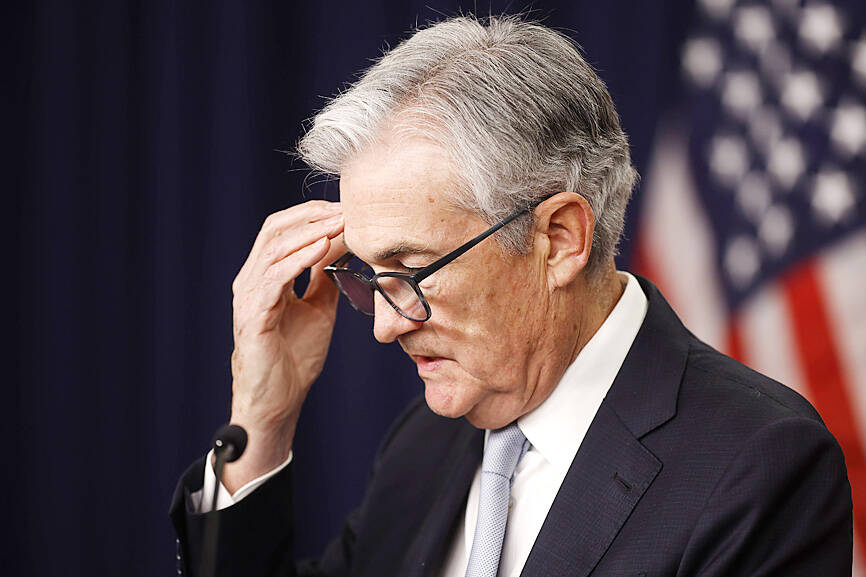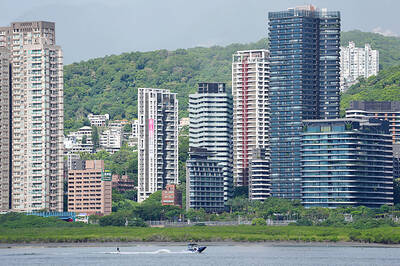The world’s most aggressive and synchronized monetary policy tightening in 40 years is entering a new phase as central banks prepare to slow the pace of interest-rate increases and break ranks over how much further they might go.
The shift toward a softer, less uniform rate-hiking campaign partly reflects growing disparities in a global economy still struggling with the aftershocks of the pandemic and Russia’s invasion of Ukraine. Another explanation is that debt burdens leave some economies more sensitive than others to tighter credit.
US growth remains resilient for now in the face of repeated rate increases by the US Federal Reserve, which last week signaled it would likely raise rates to a higher peak than previously expected, albeit at smaller increments.

Photo: AFP
Many on Wall Street see the key US rate topping 5 percent next year.
By contrast, the UK, Australia and Canada are already pulling back or indicating they might not be as aggressive in coming months amid concern that following the Fed could plunge their economies into recessions.
A swing away from what TS Lombard economist Dario Perkins calls “peak monetary synchronization” would not happen without problems.
This year’s Fed-driven surge of the US dollar is wreaking havoc among heavily indebted developing countries and advanced nations that are dependent on energy and other imports priced in the US currency.
“Things could get even messier” if US policymakers push ahead with more rate increases, and central bankers in weaker economies decide against matching them, Perkins wrote in a report last week.
The developing divergence was on full display last week. While both the Fed and the Bank of England raised interest rates by 75 basis points, their respective leaders struck different tones about what lies ahead.
For much of the past year, central banks were engaged in what Bank of America Corp economist Ethan Harris said was “a competition to see who can hike faster.”
That made sense given inflation had wrong-footed them by racing to decade-high levels with rates historically low.
However, the situation is changing even with inflation remaining above targets in most places.
Borrowing costs are significantly higher and beginning to take a bite out of growth or labor markets.
Some economies are also more sensitive than others to rising rates because of household and business debts, or housing markets that are stretched or driven by variable rate mortgages. Among them, according to Perkins: The UK, Canada, Australia, New Zealand and Norway.
“These economies will suffer recession long before the Fed has caused a US economic downturn,” he said.
So it should not be a surprise that monetary policymakers in some of these countries have paused or reduced the size of their rate moves.
A general pullback in aggressiveness still points to “the end of the beginning” of the rate-hiking campaign, AXA SA chief economist Gilles Moec said.
Bloomberg Economics predicts that the global central bank rate could reach 5.5 percent in the middle of next year, up from 2.9 percent at the end of last year. In advanced economies alone, a jump to 3.5 percent from 0.1 percent is expected.
Aggregate global inflation is running at 9 percent, almost five times the 2 percent most central banks view as price stability, according to Citigroup Inc economists, who see a 50 percent probability of a global recession next year.
Markets are now betting on a slower pace of tightening, but a higher end point. The average cash rate across advanced economies has jumped by almost 2 percentage points this year, and investors expect that average to climb by another percentage point in the coming months.
The Fed benchmark in a year’s time is expected to be 2.5 percentage points above the average across other major advanced economies, the widest gap since at least 2004. That premium is part of the reason the Intercontinental Exchange Group dollar index has soared this year to head for a record annual gain.
“The Fed keeps promising more, and the dollar keeps rising,” Harris said.

Taiwan’s rapidly aging population is fueling a sharp increase in homes occupied solely by elderly people, a trend that is reshaping the nation’s housing market and social fabric, real-estate brokers said yesterday. About 850,000 residences were occupied by elderly people in the first quarter, including 655,000 that housed only one resident, the Ministry of the Interior said. The figures have nearly doubled from a decade earlier, Great Home Realty Co (大家房屋) said, as people aged 65 and older now make up 20.8 percent of the population. “The so-called silver tsunami represents more than just a demographic shift — it could fundamentally redefine the

Businesses across the global semiconductor supply chain are bracing themselves for disruptions from an escalating trade war, after China imposed curbs on rare earth mineral exports and the US responded with additional tariffs and restrictions on software sales to the Asian nation. China’s restrictions, the most targeted move yet to limit supplies of rare earth materials, represent the first major attempt by Beijing to exercise long-arm jurisdiction over foreign companies to target the semiconductor industry, threatening to stall the chips powering the artificial intelligence (AI) boom. They prompted US President Donald Trump on Friday to announce that he would impose an additional

China Airlines Ltd (CAL, 中華航空) said it expects peak season effects in the fourth quarter to continue to boost demand for passenger flights and cargo services, after reporting its second-highest-ever September sales on Monday. The carrier said it posted NT$15.88 billion (US$517 million) in consolidated sales last month, trailing only September last year’s NT$16.01 billion. Last month, CAL generated NT$8.77 billion from its passenger flights and NT$5.37 billion from cargo services, it said. In the first nine months of this year, the carrier posted NT$154.93 billion in cumulative sales, up 2.62 percent from a year earlier, marking the second-highest level for the January-September

Asian e-commerce giant Shein’s (希音) decision to set up shop in a historic Parisian department store has ruffled feathers in the fashion capital. Anger has been boiling since Shein announced last week that it would open its first permanent physical store next month at BHV Marais, an iconic building that has stood across from Paris City Hall since 1856. The move prompted some French brands to announce they would leave BHV Marais, but the department store had already been losing tenants over late payments. Aime cosmetics line cofounder Mathilde Lacombe, whose brand was among those that decided to leave following